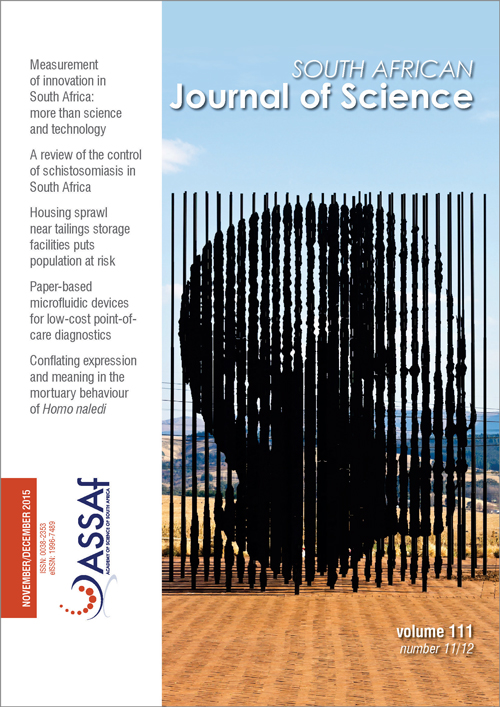Incidence of non-typhoidal Salmonella in poultry products in the North West Province, South Africa
DOI:
https://doi.org/10.17159/sajs.2015/20140233Keywords:
food-borne salmonellosis, broiler, invA, spvC, fingerprintingAbstract
This study was conducted to evaluate the incidence of non-typhoidal Salmonella (NTS) serotypes in raw and ready-to-eat (RTE) broiler products in the North West Province of South Africa. A total of 120 raw broiler samples, 40 samples of polonies and 20 samples of smoked viennas were obtained from retail points in major cities and towns in the province. Samples were subjected to aerobic plate count and later screened for the presence of NTS using phenotypic and genotypic techniques. The average bacterial count in raw products was 3.1 x 105 cfu/g whereas bacterial contamination of RTE products was 1.8 x 103 cfu/g. The average recovery rate of NTS species from raw broiler products was 12.5% and the serotypes identified were S. typhimurium (46.4%), S. enteritidis (30.9%) and S. newport (22.9%). No NTS was recovered from the RTE products. However, S. typhimurium was the predominant serotype in whole carcasses whereas S. enteritidis and S. newport were prevalent in chicken parts. Out of the 160 presumptive NTS isolates screened by polymerase chain reaction (PCR), 140 (87.5%) were confirmed for the presence of the Salmonella-specific invA gene. In addition, 115 (82.4%) of the confirmed isolates harboured the plasmid spvC gene. Random Amplified Polymorphic DNA (RAPD) fingerprinting of isolates using RAPD 1 and RAPD 3 primers, revealed some inter- and intra-serotype genetic diversity among isolates, suggesting varying sources of contamination. The results of this study represent the first report on the incidence and prevalent serotypes of NTS in chicken products in the North West Province of South Africa.
Published
Issue
Section
License

All articles are published under a Creative Commons Attribution 4.0 International Licence
Copyright is retained by the authors. Readers are welcome to reproduce, share and adapt the content without permission provided the source is attributed.
Disclaimer: The publisher and editors accept no responsibility for statements made by the authors
How to Cite
- Abstract 569
- PDF 882
- EPUB 214
- XML 273












.png)